As a pet owner, it’s essential to create a safe and welcoming environment for your furry friends. One way to achieve this is by choosing pet-friendly houseplants that not only beautify your home but also ensure your pets’ safety.
Many common houseplants can be toxic to pets, so it’s crucial to select plants that are non-toxic and safe. Fortunately, there are numerous pet-safe plants that also look great, such as the Money Tree Plant, Ponytail Palm Tree, and Areca Palm Indoor Tree.
Having plants in your home can enhance your decor and improve air quality, but it’s vital to prioritize your pets’ safety. This article will explore various pet-friendly plants that can bring beauty and freshness to your home without putting your pets at risk.
Key Takeaways
- Choose pet-friendly houseplants to ensure your pets’ safety.
- Some plants, like the Money Tree Plant, are non-toxic to pets.
- Pet-safe plants can enhance your home decor and air quality.
- Prioritize your pets’ safety when selecting houseplants.
- There are many beautiful pet-friendly plants to choose from.
Why Pet-Safe Plants Matter for Pet Owners
Pet owners often overlook the potential dangers lurking in their home’s greenery, making it essential to understand the importance of pet-safe plants. Many common houseplants can be toxic to pets, causing a range of symptoms from mild discomfort to severe illness. By choosing pet-safe plants, pet owners can create a safe and welcoming environment for their pets.
Common Toxic Plants to Avoid
Some plants are notoriously toxic to pets. For example, Lily plants are highly toxic to cats, and even small amounts can cause severe kidney damage. Similarly, Sago Palm is toxic to dogs, and ingestion of any part of the plant can lead to liver failure. Being aware of these toxic plants is the first step in creating a pet-friendly home.
Benefits of Having Plants in a Pet-Friendly Home
Having plants in a pet-friendly home offers numerous benefits. Not only do plants purify the air and improve the aesthetic appeal of a home, but they also contribute to a healthier environment. Non-toxic indoor plants like Spider Plants and Boston Ferns are not only safe for pets but also easy to care for, making them perfect for busy pet owners. By incorporating these plants into their homes, pet owners can enjoy the companionship of their pets in a healthier, more welcoming space.
Understanding Plant Toxicity for Different Pets
Pet owners often overlook the potential dangers that certain plants pose to their pets, highlighting the need for awareness about plant toxicity. Different pets react differently to the same plant, making it crucial to understand these differences to ensure a safe and healthy environment for your pets.
Toxicity Differences for Cats vs. Dogs
Cats and dogs have different sensitivities to plant toxins. For instance, plants like the Majesty Palm and Parlor Palm are considered safe for both cats and dogs. However, other plants can be highly toxic to one or both. Understanding these differences is key to pet-friendly gardening.
| Pet | Common Toxic Plants | Safe Plants |
|---|---|---|
| Cats | Lily, Tulip | Spider Plant, Parlor Palm |
| Dogs | Chocolate Lily, Oleander | Majesty Palm, Swedish Ivy |
Signs Your Pet Has Ingested a Toxic Plant
If your pet has ingested a toxic plant, signs may include vomiting, diarrhea, lethargy, and in severe cases, seizures or coma. If you suspect your pet has ingested a toxic plant, it’s crucial to seek veterinary care immediately. Keeping pet-safe foliage is a proactive step in preventing such incidents.
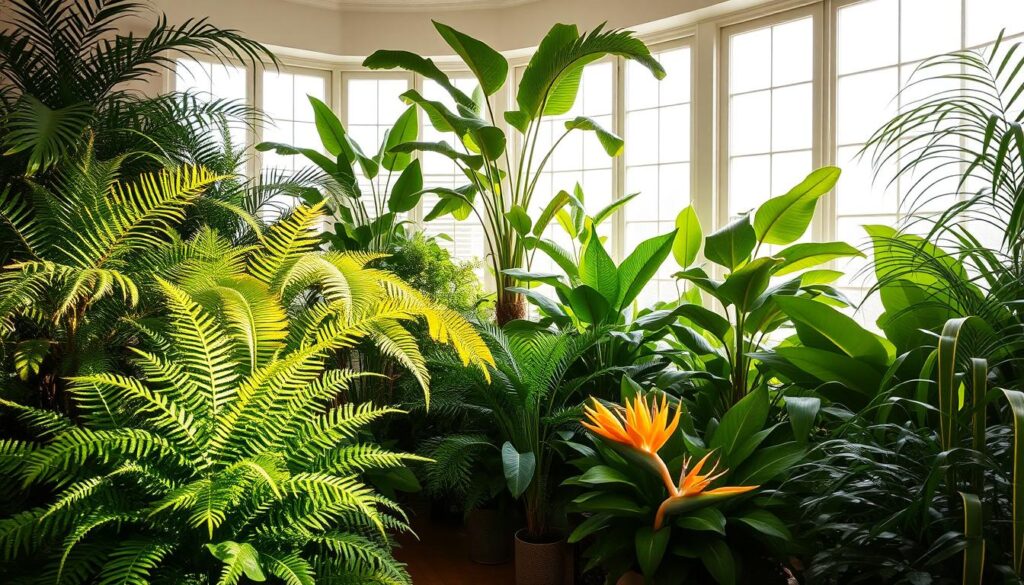
Pet-Safe Plants That Also Look Great: Our Top Picks
Creating a pet-friendly home doesn’t mean sacrificing style, thanks to a wide range of gorgeous and safe plants. When selecting plants for your home, it’s essential to choose varieties that are non-toxic to pets. Here, we’ll explore some of our top picks for pet-safe plants that add a touch of elegance and drama to your indoor space.
Statement Plants for Dramatic Impact
For those looking to make a statement with their indoor plants, there are several pet-safe options that can add a dramatic touch to any room.
Majesty Palm and Bird of Paradise
The Majesty Palm is a popular choice for indoor spaces due to its elegant, feathery fronds. It’s not only safe for pets but also adds a tropical vibe to your home. The Bird of Paradise is another striking option, known for its vibrant orange and purple flowers that resemble a bird’s beak. Both plants are sure to be conversation starters.
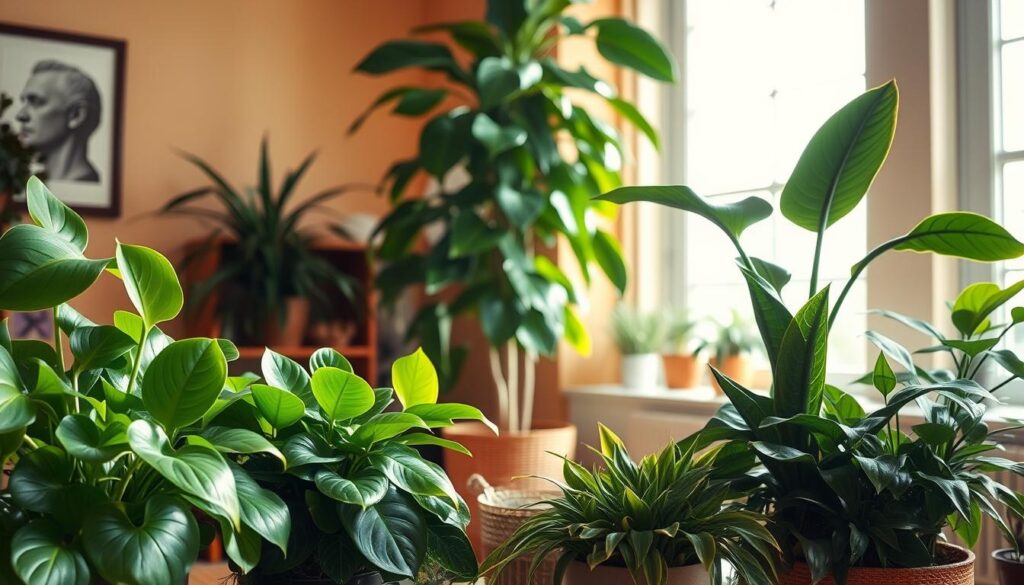
The Areca Palm is a pet-safe plant that’s also great for air purification, making it a healthy addition to your home. The Ponytail Palm, with its unique bulbous trunk and curly leaves, adds a quirky touch to any room. Both are safe for your pets and can thrive in indoor conditions with proper care.
Delicate Beauties for Subtle Elegance
For a more subtle approach to indoor decor, there are several pet-safe plants that offer understated elegance.
Chinese Money Plant (Pilea)
The Chinese Money Plant, also known as Pilea, is a stylish and pet-friendly option. Its round, flat leaves are not only beautiful but also easy to care for, making it perfect for busy pet owners.
Friendship Plant (Pilea involucrata)
The Friendship Plant is another variety of Pilea that’s safe for pets. Its attractive foliage and compact growth make it an excellent choice for indoor pots and planters.
| Plant Name | Pet Safety | Care Level |
|---|---|---|
| Majesty Palm | Safe | Medium |
| Bird of Paradise | Safe | High |
| Chinese Money Plant | Safe | Low |
| Friendship Plant | Safe | Low |
Stunning Trailing and Hanging Pet-Safe Plants
For pet owners who love plants, there are numerous stunning trailing and hanging pet-safe plants that can enhance home decor. These plants not only add a touch of elegance to any room but also ensure the safety of your pets.
Trailing and hanging plants are particularly popular for their ability to add greenery to spaces without taking up too much floor or surface area. They can be draped from ceilings, placed on high shelves, or hung in baskets, making them versatile options for home gardening with pets.
Spider Plants: The Classic Pet-Safe Hanging Plant
Spider Plants are a favorite among plant enthusiasts due to their ease of care and air-purifying qualities. They are great for hanging baskets and can thrive in a variety of lighting conditions, making them perfect for different rooms in your home.
Boston Ferns: Lush Green Cascades
Boston Ferns bring a lush, green cascade to any space, adding a tropical feel to your home. They prefer bright, indirect light and consistent moisture, making them a beautiful yet low-maintenance option for pet owners.
Swedish Ivy and Lipstick Plant
Swedish Ivy and Lipstick Plant are other excellent choices for pet-safe trailing plants. Swedish Ivy is known for its fast growth and ability to thrive in various lighting conditions, while Lipstick Plant adds a pop of color with its vibrant flowers. Both are safe for your pets and can add a unique touch to your home decor.
Gorgeous Flowering Pet-Safe Plants
Gorgeous flowering plants can elevate the aesthetic of any room, and fortunately, many are safe for pets. These plants not only add a pop of color but also bring vibrancy and life to your home without compromising your pet’s safety.
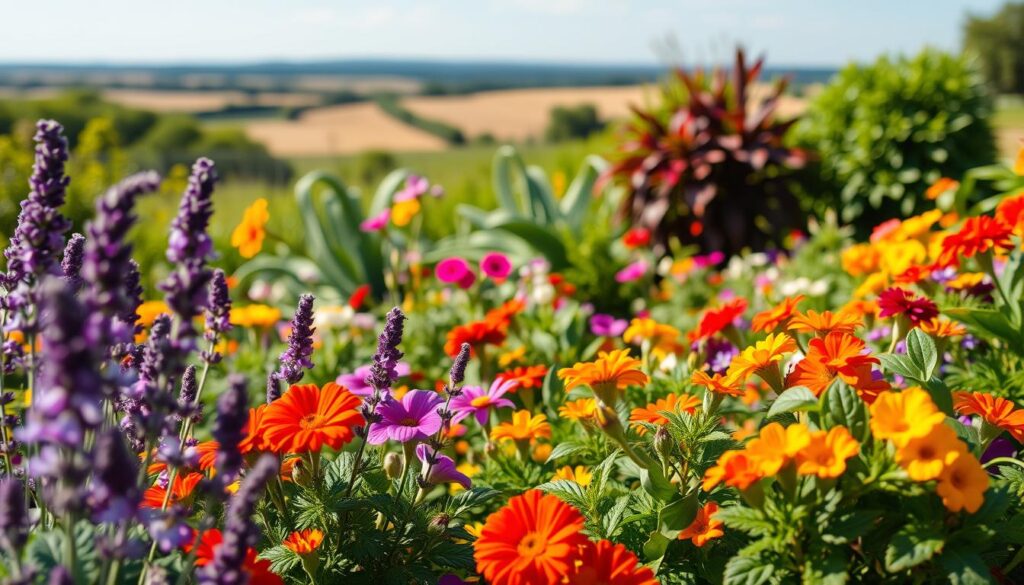
African Violets and Gloxinia
African Violets and Gloxinia are two beautiful, flowering plants that are safe for your pets. They come in a variety of colors, including purple, pink, and white, adding a delicate touch to any room. These plants thrive in bright, indirect light and require moderate watering, making them relatively low maintenance.
Orchid Varieties Safe for Furry Friends
Orchids are known for their exotic beauty and are generally safe for pets. Varieties like Phalaenopsis and Dendrobium are not only beautiful but also non-toxic to cats and dogs. They require careful watering and bright, indirect light, making them a great choice for pet owners who want to add some elegance to their homes.
Christmas Cactus and Easter Cactus
Christmas Cactus and Easter Cactus are seasonal flowering plants that are safe for pets. They bloom around the holiday seasons, adding a festive touch to your home. These plants are relatively easy to care for, requiring moderate watering and indirect light. They are perfect for pet owners who want to enjoy the beauty of flowering plants without worrying about their pets’ safety.
| Plant | Lighting | Watering | Pet Safety |
|---|---|---|---|
| African Violets | Bright, indirect | Moderate | Safe |
| Orchids | Bright, indirect | Careful | Safe |
| Christmas Cactus | Indirect | Moderate | Safe |
Pet-Safe Succulents and Desert Plants
Succulents and desert plants are not only low-maintenance but also pet-friendly, making them perfect for homes with pets. These plants come in a variety of shapes, sizes, and colors, offering something for every interior design style.
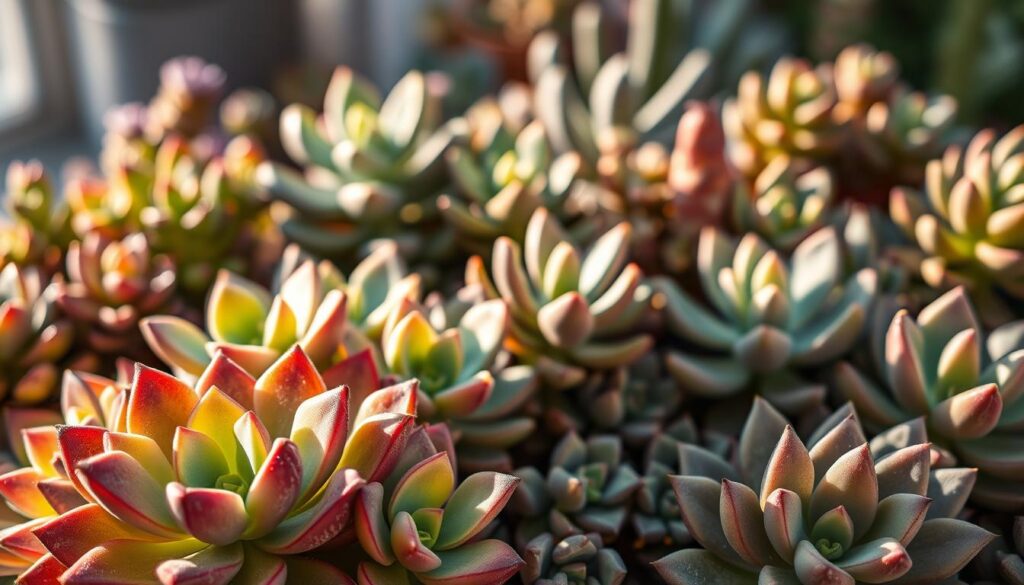
Haworthia and Echeveria
Haworthia and Echeveria are two popular succulent genera that are safe for pets. Haworthia is known for its striking, fleshy leaves that often feature beautiful white or light-colored markings. Echeveria, on the other hand, boasts rosettes of leaves in a range of colors, from soft pastels to vibrant hues. Both are relatively small and can thrive in indoor conditions with proper care.
Air Plants: Tillandsia Varieties
Air plants, or Tillandsia, are epiphytes that don’t require soil and are safe for your furry friends. These unique plants absorb moisture and nutrients through their leaves, making them a fascinating addition to any pet-friendly home. With proper care, Tillandsia can bloom beautiful flowers, adding a touch of elegance to your space.
Blue Echeveria and Hens and Chicks
Blue Echeveria is a stunning succulent with powdery blue leaves that form a beautiful rosette. “Hens and Chicks” (Sempervivum) is another pet-safe succulent that gets its name from the way the mother plant (the “hen”) produces offsets (the “chicks”). Both are hardy, low-maintenance options that can add a decorative touch to your home without posing a risk to your pets.
Lush Foliage Plants Safe for Pets
You can bring the outdoors in with beautiful, pet-safe foliage plants that add a touch of natural elegance to your home. Lush foliage plants are not only aesthetically pleasing, but they also help purify the air and create a calming atmosphere. By choosing pet-safe options, you can enjoy the benefits of having plants in your home without worrying about your furry friends.
Calathea and Prayer Plants
Calathea and Prayer Plants are stunning additions to any room, with their vibrant, colorful leaves. These plants are not only pet-safe but also relatively low-maintenance. Calathea plants prefer bright, indirect light, while Prayer Plants can thrive in a variety of lighting conditions. With proper care, these plants can add a pop of color and texture to your space.
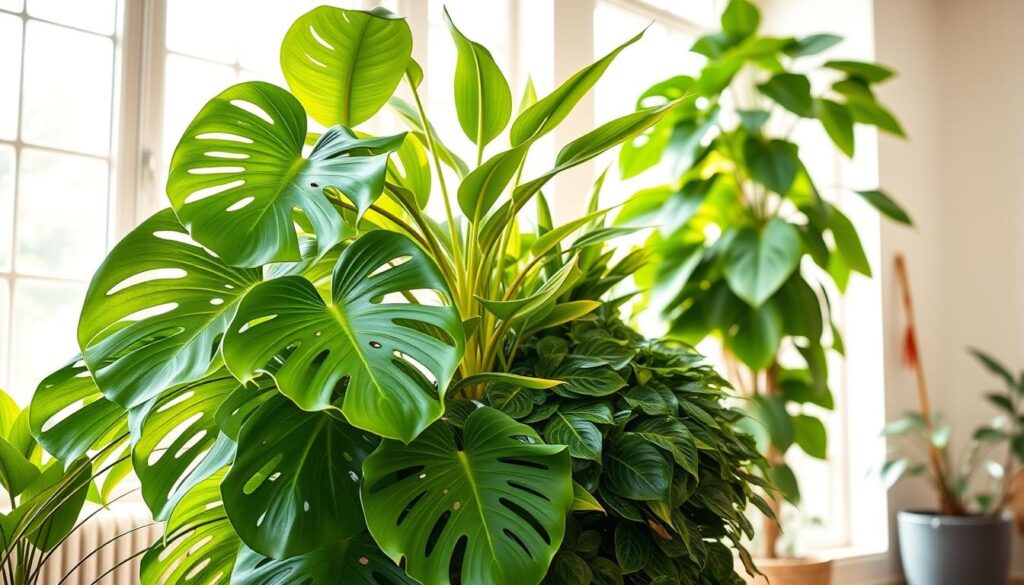
Parlor Palms and Bamboo Palms
Parlor Palms and Bamboo Palms are elegant, pet-friendly options that can bring a touch of tropical flair to your home. These palms are known for their slender leaves and ability to grow in low-light conditions, making them perfect for rooms with limited natural light. They are also relatively easy to care for, requiring only occasional watering and fertilization.
Peperomia Varieties and Aluminum Plant
Peperomia Varieties and the Aluminum Plant are other great options for pet-safe foliage. Peperomia plants come in a range of shapes and sizes, with beautiful, heart-shaped leaves. The Aluminum Plant, with its striking silver markings, adds a unique touch to any room. Both plants are relatively low-maintenance and can thrive in a variety of lighting conditions, making them perfect for pet owners who want to add some greenery to their space.
Seasonal Pet-Safe Plants for Year-Round Beauty
You can enjoy the changing seasons with a range of pet-safe plants that will keep your home looking great and your pets safe. By incorporating seasonal plants into your decor, you can refresh your space and keep it looking vibrant throughout the year.
Spring and Summer Options
During the spring and summer months, consider adding African Violets and Gloxinia to your home. These flowering plants are not only beautiful but also safe for your pets. Spider Plants are another great option, known for their ease of care and pet-friendly nature.
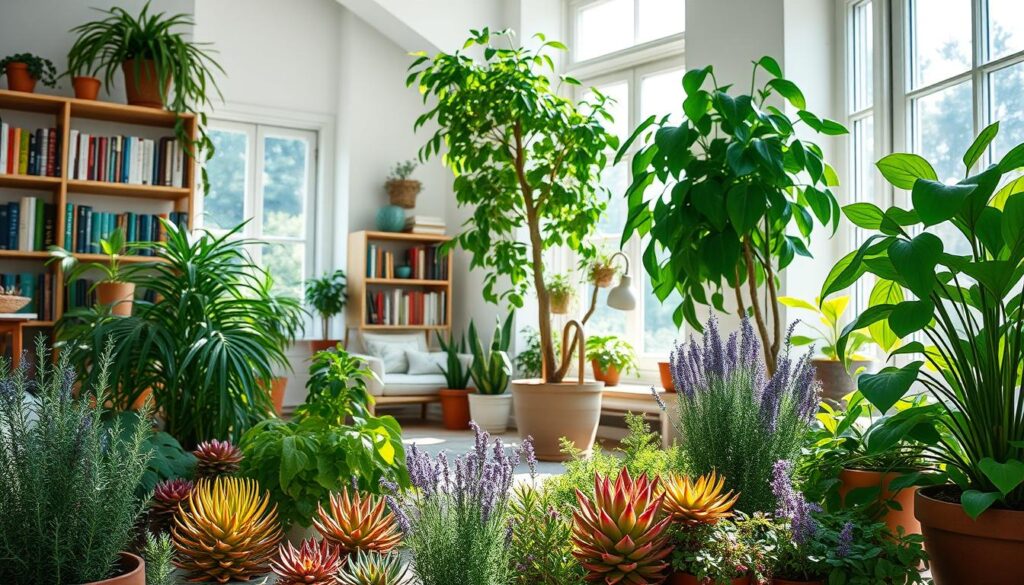
Fall and Winter Pet-Safe Plants
As fall and winter approach, you can transition to plants like Christmas Cactus and Easter Cactus, which are safe for your pets and add a festive touch to your home. Parlor Palms are also a great choice for the colder months, providing a lush, green element to your decor.
By choosing the right seasonal pet-safe plants, you can enjoy a beautiful and safe home environment for both you and your pets.
Creating Pet-Friendly Plant Displays
With a few simple tips, you can create a stunning and safe plant display for your home. The key is to balance your love for plants with the safety of your pets. By choosing the right display methods, you can enjoy your pet-safe plants that also look great while keeping your pets safe.
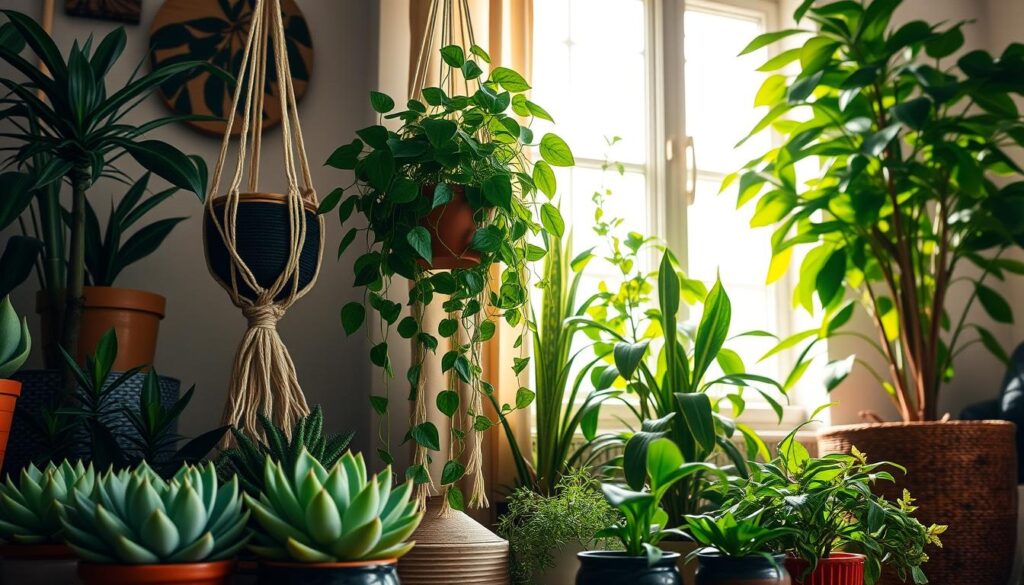
Elevated Plant Stands and Hanging Solutions
One effective way to keep plants out of pets’ reach is by using elevated plant stands and hanging solutions. These not only add a decorative element to your home but also ensure that your plants are safely out of your pets’ grasp. Consider using:
- High shelves or plant stands that are difficult for pets to access.
- Hanging baskets or macramé hangers to suspend plants from the ceiling.
- Wall-mounted planters to add greenery without taking up floor space.
Creative Ways to Keep Plants and Pets Separate
In addition to elevated displays, there are other creative ways to keep plants and pets separate. For example, you can:
- Create a dedicated plant room or area that is off-limits to pets.
- Use barriers or gates to restrict access to plants.
- Choose plants with unappealing textures or scents to deter pets from investigating.
By implementing these strategies, you can enjoy your pet-friendly houseplants while maintaining a safe environment for your pets.
Care Tips for Pet-Safe Plants
To keep your pet-safe plants thriving, it’s essential to understand their specific care needs. Proper care not only ensures the longevity of your plants but also contributes to a safe and healthy environment for your pets.
Light and Water Requirements
Different pet-safe plants have varying light and water requirements. For instance, plants like Spider Plants and Prayer Plants prefer bright, indirect light, while others like Chinese Evergreen can tolerate low light conditions. Overwatering is a common mistake; check the soil moisture by inserting a finger into the soil up to the first knuckle. If the soil feels dry, it’s time to water. “The key to keeping your plants alive is to observe their responses to different conditions and adjust accordingly,” as noted by gardening experts.
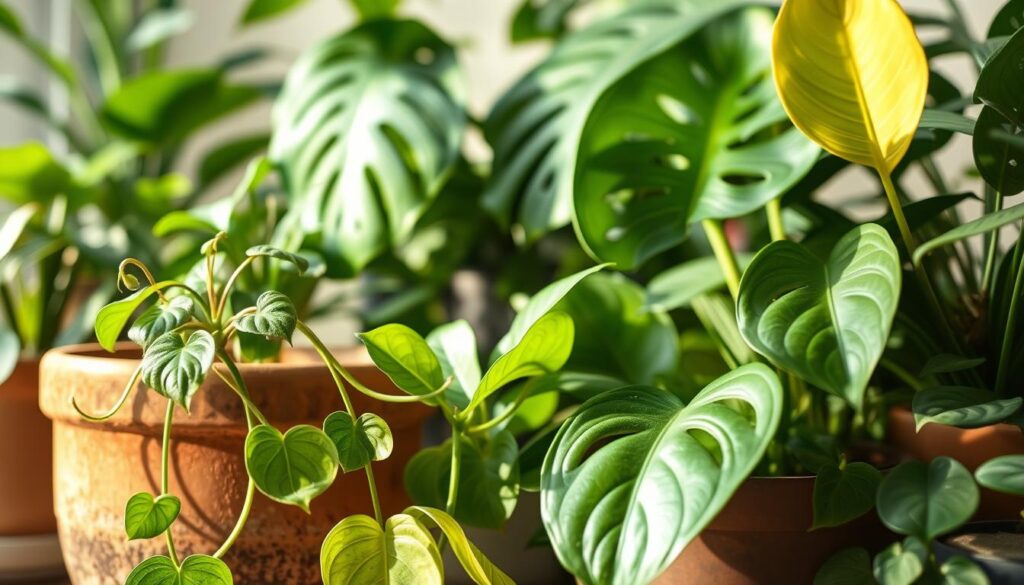
Pet-Safe Fertilizers and Soil Options
Using pet-safe fertilizers and soil options is crucial to prevent accidental poisoning. Opt for organic fertilizers that are free from harmful chemicals. A well-draining potting mix is also recommended to prevent waterlogged soil, which can lead to root rot. Consider using a mix specifically designed for indoor plants, as it will be formulated to meet their unique needs. As gardening experts suggest, “A balanced fertilizer will promote healthy growth without risking your pet’s health.”
By following these care tips, you can enjoy your non-toxic indoor plants while keeping your pets safe and happy.
Pet-Friendly Outdoor Plants for Gardens
Creating a pet-friendly garden is a top priority for many homeowners who want to ensure their outdoor spaces are safe for their furry friends. By choosing the right plants, you can create a beautiful and safe outdoor environment for your pets to enjoy.
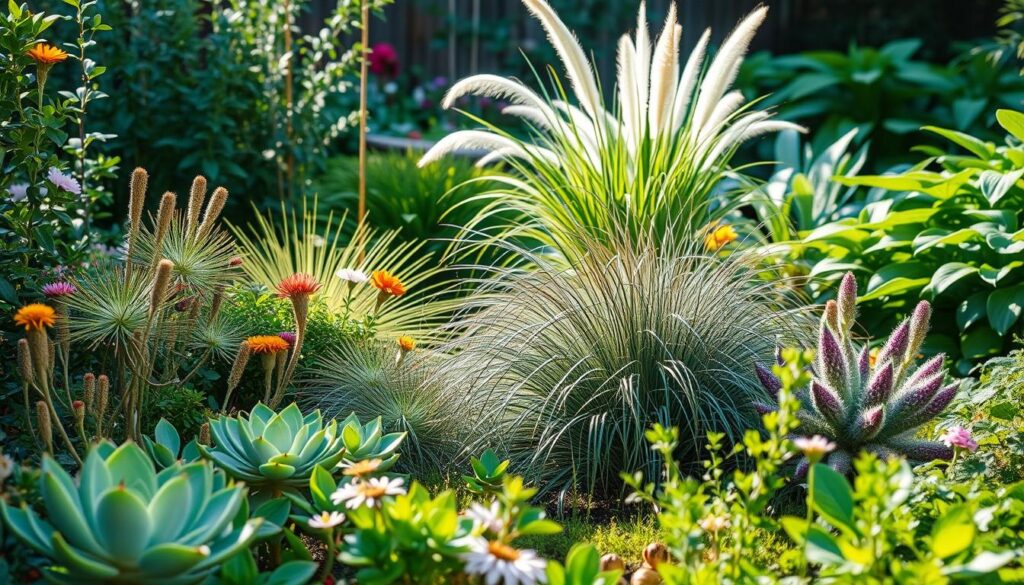
Safe Flowering Perennials
When it comes to flowering perennials, there are many pet-friendly options to choose from. Some popular choices include coneflowers, black-eyed susans, and catmint. These flowers are not only beautiful, but they’re also non-toxic to pets. As one expert notes, “Choosing the right plants for your garden can make all the difference in creating a safe and enjoyable space for your pets.”
Pet-Safe Shrubs and Ground Covers
In addition to flowering perennials, there are many pet-safe shrubs and ground covers that can add beauty and texture to your garden. Some great options include creeping thyme, sedum, and boxwood. These plants are all non-toxic to pets and can be used to create a lush, inviting outdoor space. By incorporating these plants into your garden, you can create a safe and welcoming environment for your pets to explore.
Conclusion: Creating a Beautiful, Pet-Safe Indoor Garden
Transforming your home into a haven for both you and your pets is easier than you think. By choosing pet-safe plants like the Spider Plant and incorporating them into your decor, you can enjoy a lush, welcoming space. Pet-friendly plant decor not only enhances the aesthetic of your home but also ensures the well-being of your furry friends.
When planning your indoor garden, consider the benefits of indoor plants safe for pets, such as air purification and stress reduction. Home gardening with pets requires careful selection of plants, but with the right choices, you can create a beautiful and safe environment. Elevated plant stands and hanging solutions can help keep plants out of reach, adding a creative touch to your pet-friendly home.
By following the tips and recommendations provided, you can cultivate a stunning indoor garden that is both beautiful and safe for your pets. So, get started on creating your pet-safe haven today, and enjoy the beauty and serenity it brings to your home.



